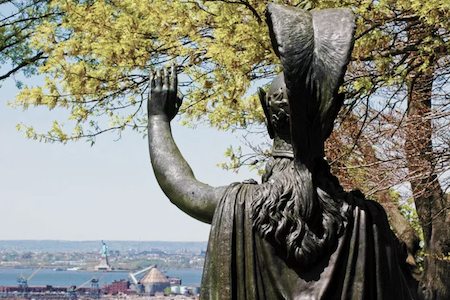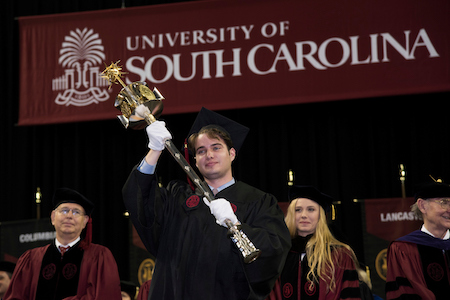The Horseshoe is the oldest part of the University of South Carolina's campus, but there is something older still — the university seal and motto. A little knowledge (or a quick tutorial) in Latin and Roman mythology is a prerequisite for understanding both.
TRANSCRIPT
When you stand here in the middle of the Horseshoe at the University of South Carolina, your feet are planted in the heart of the university’s historic campus. And when you look at Rutledge College, you’re looking at the place where it all began, Carolina’s first building that opened its doors in 1805.
But there is something that predates even Rutledge and the Horseshoe in historic and symbolic significance to USC. I’m Chris Horn, your host for Remembering the Days, and today we’re taking a closer look at the university motto and the university seal. Both of them represent the essence of the University of South Carolina. Understanding them requires a little guidance in Latin as well as Roman mythology.
Emollit Mores Nec Sinit Esse Feros
In case you’re not well-versed or not-at-all-versed in Latin, what you just heard is Carolina’s official motto. It’s a line that the Roman poet Ovid wrote in the first century. Translated into English it means “Learning humanizes character and does not permit it to be cruel.”

The first students at Carolina would have understood the Latin, and they would have known who Ovid was. That’s because USC began as a liberal arts college that emphasized classic languages and literature.
I don’t know the first thing about Latin, so I went to USC’s classics department for a little help. Department chair Hunter Gardner and faculty member Jason Osborne explained that Ovid, the Roman poet, had somehow run afoul of the government and had been exiled from Rome to a distant and dismal port in the Black Sea. He found himself surrounded by people who were not at all like the gentle folk back in Rome.
Jason Osborne: “You know, Rome is still nice to wander around with the ruins, but if you can imagine those things in their full splendor and glory, that's about the nicest place you could live. And now he's there. He's in the Black Sea. It's dark. It's cold. It's cold in a way that he probably hasn't experienced. And society there is very, very different.
Hunter Gardner: “Yeah, he's trying to appeal to the better character of some of the people in the area, to instill in them culture.”
So, Ovid was hoping that education, learning would refine the character of the people around him, perhaps make them a bit more enlightened, a little less crude. It reminds me of a more plainspoken translation of USC’s motto that says: “It takes a roughneck and makes a gentleman of him.” One could say that that was more or less the point of higher education in the early 1800s.
The first generations of students at South Carolina College were often a rowdy bunch, gambling, drinking, getting into trouble. Go back and listen to the episode about 19th-century student pranks if you need a reminder.
Those students enrolled at Carolina, and if they stuck around long enough and paid attention to their studies, the refining qualities of education began to take effect.
Hunter Gardner: “The cavorting and carousing and maybe occasional dueling that these young men, would engage in, you know, that is a coming-of-age step. So is entering the university and then coming out on the other side as a gentleman.
Jason Osborne: “A gentleman fit to be a citizen statesman. In the tradition of Cicero. And that's really a goal, an ideal, something that they're looking for.”
We could call the motto — Learning humanizes character and does not permit it to be cruel — USC’s vision statement. And in the same vein, the university seal speaks to the soul of the institution. University seals have been around since the 12th century in Europe, so USC’s seal is relative late-comer to the party, even though it was adopted a couple of years before the university opened its doors in 1805.
If you’re a USC graduate, you can find the university seal on your diploma. It’s an oval-shaped piece of artwork that contains the university motto and depicts two Roman goddesses shaking hands.
The one on the left is Libertas, the Roman goddess of liberty, and the one on the right is Minerva, the premier goddess of wisdom. Our two classics professors speculate that since the Revolutionary War had ended only 20 years before South Carolina College was chartered, the idea of liberty was fresh in mind when the seal was adopted in 1803.
Jason Osborne: “The revolution, I think is key. Libertas with Minerva, that generation really tied classical education, specifically in Roman republicanism, to the kind of freedom that they wanted to create, they wanted to emulate. You're educated into freedom. So putting these two together is specifically important, specifically tied to that generation.”
Hunter Gardner: “This reminds me that liberal arts, I mean, that whole term comes from the Roman idea of only a free-born person really was, in the Roman mind, suited for this kind of education, where it was poetry, rhetoric, not some of the things like the sciences and medicine that we now sort of revere. For the Romans, it was the study of literature and public speaking.”
So, the Roman goddesses of liberty and wisdom face each other and shake hands on the University of South Carolina seal. It’s the sort of noble ideal that I don’t think anyone would argue with. It’s worth noting that Minerva, the goddess of wisdom, carries a shield emblazoned with the seal of the state of South Carolina — so we have a seal embedded within a seal. Libertas carries a long torch, which might remind you of another famous figure, the Statue of Liberty on Ellis Island in New York.
That Liberty or Libertas holds a torch in her hand as she gazes across New York Harbor. There is a statue of Minerva, the wisdom goddess, located in Brooklyn, N.Y. That Minerva is situated three and a half miles away from the Statue of Liberty, but Minerva is positioned so that she is looking directly at the Statue of Liberty. It’s a larger than life depiction of the University of South Carolina seal.

There is one more symbol of the university that is seldom seen but important nonetheless. It’s the university mace, and your best opportunity to lay eyes on it is at a commencement ceremony in the spring or fall. The large silver and gold ornamental staff is about four feet long and is carried up to the stage where all of the university dignitaries preside over graduation.
The University Mace was fashioned by an English silversmith and dedicated in 1967. I’m going to describe it to you because the mace has a lot of details that can’t be seen unless you’re really up close. The head of the mace is mounted with the University and state of South Carolina seals, as well as the Great Seal of the United States. The tip of the mace resembles South Carolina’s state tree, the palmetto, and the palmetto fronds are formed by 13 stars, representing the founding Colonies, including South Carolina. The shaft of the mace is decorated with eight stars, reminding us that South Carolina was the eighth state to enter the Union.
The mace is considered to be the embodiment of the university, and the president of Student Government has the privilege and responsibility of carrying the mace at commencement ceremonies. I asked Emmie Thompson, the current Student Government president, what it’s like to be entrusted with such a giant piece of bling.
Emmie Thompson: “I think it's a really special honor that the student body president gets to carry that and lead the whole platform party out at graduation. During the spring commencement, that was when they gave me the big rundown on just kind of the history of the mace. Don’t drop it! They told me you have to handle it with gloves. Always. It is a little heavy, so they make sure somebody else carries it for you until you get out to the entrance of Colonial Life. So they did kind of walk me through, like, how I hold it. The university seal always faces out on the front.”
Of all three symbols — motto, seal and mace — I suppose the one that we rub elbows with the most is the motto. I mean, we don’t go around spouting the Latin phrase, but as Carolina graduates or graduates of any college or university, our learning, hopefully, has refined us. It has humanized our character.
That’s all for this episode. On the next Remembering the Days, we’re going back to 1965 when a special basketball team led by a special coach did the unimaginable in their first conference game of the season. Find out what happened from one of the USC star players of that game and two of the fans who watched it happen. Until then, I’m Chris Horn, forever to thee.